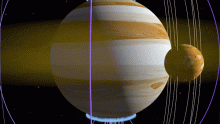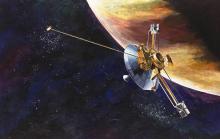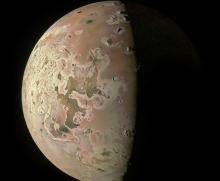Listen to today's episode of StarDate on the web the same day it airs in high-quality streaming audio without any extra ads or announcements. Choose a $8 one-month pass, or listen every day for a year for just $30.
You are here
Moon and Jupiter
If you look long enough and hard enough at Jupiter, there’s a good chance you’ll find another moon of the giant planet. Earlier this year, for example, astronomers announced the discovery of two moons, bringing Jupiter’s total to 69. The new discoveries aren’t much to get excited about on their own, though — each is a chip of rock only a mile or so across.
Last year, Scott Sheppard was scanning the outer solar system for a possible Planet Nine when Jupiter crossed his field of view. Using a large telescope in Chile, he discovered a possible new moon orbiting the solar system’s largest planet. The find was confirmed earlier this year when he teamed up with other astronomers, who were using an even bigger telescope.
The second moon was first seen in March of this year. A scan through photos of the region snapped last year also showed the moon, allowing the astronomers to confirm it and plot its orbit.
Both moons are many millions of miles from Jupiter, so it takes a year and a half for one of them to complete an orbit, and two years for the other. And both orbit backwards. That suggests that they were asteroids that passed close to the planet, where they were captured by its powerful gravity — adding to its big family of moons.
And Jupiter teams up with our own moon this evening. The planet looks like a brilliant star close to the lower right of the crescent Moon. The true star Spica stands below the Moon.
Script by Damond Benningfield





